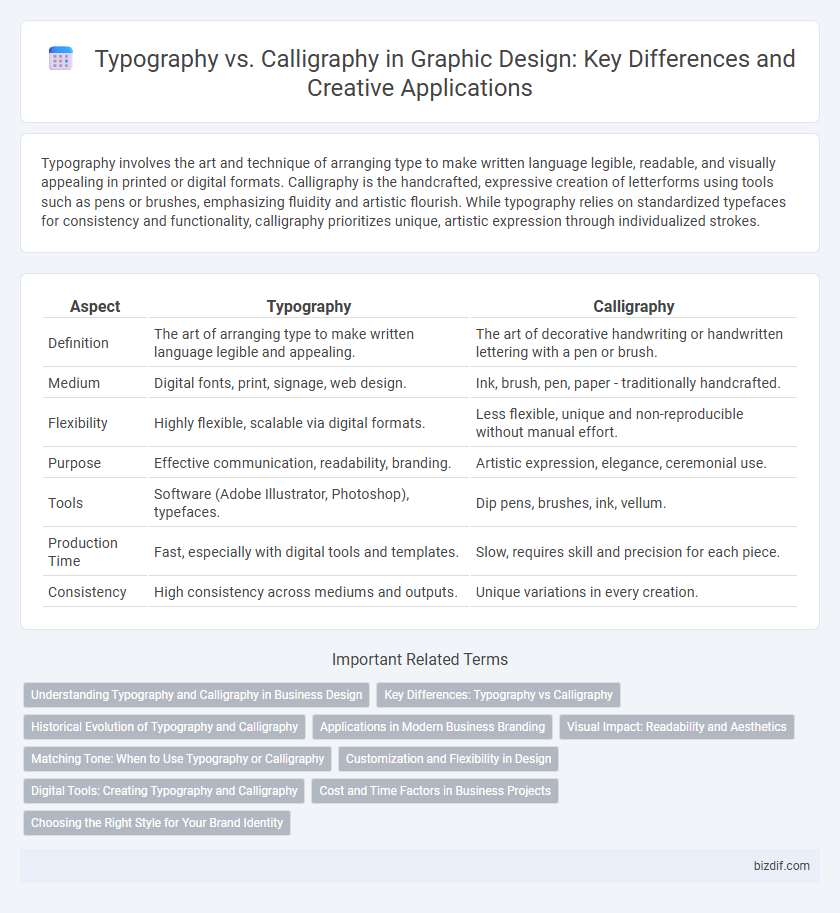Typography involves the art and technique of arranging type to make written language legible, readable, and visually appealing in printed or digital formats. Calligraphy is the handcrafted, expressive creation of letterforms using tools such as pens or brushes, emphasizing fluidity and artistic flourish. While typography relies on standardized typefaces for consistency and functionality, calligraphy prioritizes unique, artistic expression through individualized strokes.
Table of Comparison
| Aspect | Typography | Calligraphy |
|---|---|---|
| Definition | The art of arranging type to make written language legible and appealing. | The art of decorative handwriting or handwritten lettering with a pen or brush. |
| Medium | Digital fonts, print, signage, web design. | Ink, brush, pen, paper - traditionally handcrafted. |
| Flexibility | Highly flexible, scalable via digital formats. | Less flexible, unique and non-reproducible without manual effort. |
| Purpose | Effective communication, readability, branding. | Artistic expression, elegance, ceremonial use. |
| Tools | Software (Adobe Illustrator, Photoshop), typefaces. | Dip pens, brushes, ink, vellum. |
| Production Time | Fast, especially with digital tools and templates. | Slow, requires skill and precision for each piece. |
| Consistency | High consistency across mediums and outputs. | Unique variations in every creation. |
Understanding Typography and Calligraphy in Business Design
Typography in business design emphasizes legibility, consistency, and scalability to ensure clear brand communication across digital and print media. Calligraphy offers a unique, handcrafted aesthetic that conveys sophistication and personality but may sacrifice readability in smaller formats. Balancing typography's structured approach with calligraphy's artistic flair enhances brand identity while maintaining functional design elements.
Key Differences: Typography vs Calligraphy
Typography involves the structured arrangement of typefaces to create visually appealing and readable text in digital and print media, emphasizing consistency and scalability. Calligraphy is the art of hand-drawing letters with diverse strokes and styles, focusing on artistic expression and unique, fluid forms. Key differences include typography's use of digital fonts and predefined character sets versus calligraphy's handcrafted, one-of-a-kind letterforms created with specialized tools like brushes and nib pens.
Historical Evolution of Typography and Calligraphy
Typography evolved from movable type invented by Johannes Gutenberg in the 15th century, revolutionizing mass communication and printing techniques. Calligraphy traces back to ancient civilizations like Egypt and China, emphasizing handcrafted, artistic letterforms with cultural and ceremonial significance. Both disciplines influenced each other, with typography adopting stylistic elements from calligraphy to enhance legibility and aesthetic appeal in modern graphic design.
Applications in Modern Business Branding
Typography in modern business branding offers scalable, consistent font styles ideal for digital and print media, enhancing brand readability and recognition. Calligraphy provides a personalized, artistic touch that conveys luxury and craftsmanship, often used in logos and packaging to evoke emotional connections. Combining typography's clarity with calligraphy's elegance can create versatile brand identities that stand out across diverse marketing platforms.
Visual Impact: Readability and Aesthetics
Typography enhances visual impact through structured fonts that prioritize readability and consistent aesthetics across digital and print media. Calligraphy offers a more artistic and personalized aesthetic, with fluid strokes that emphasize individual expression but can sometimes compromise legibility. Both disciplines balance aesthetics and readability differently, influencing how visual messages are perceived in graphic design.
Matching Tone: When to Use Typography or Calligraphy
Typography provides consistent, easily readable text ideal for professional and digital communications, while calligraphy offers an artistic, personalized touch suited for invitations, branding, and decorative projects. Matching tone requires assessing the audience and purpose; typography fits formal, corporate, and straightforward messages, whereas calligraphy conveys elegance, creativity, and individuality. Use typography for clarity and efficiency, calligraphy to evoke emotion and uniqueness in design.
Customization and Flexibility in Design
Typography offers extensive customization through digital tools that allow precise control over font style, size, spacing, and alignment, making it highly adaptable for various design projects. Calligraphy, while more organic and artisanal, provides unique flexibility through hand-crafted strokes that bring a personal, expressive touch impossible to replicate exactly in digital typefaces. Designers often combine both to leverage typography's scalability and calligraphy's individuality, achieving balance between uniformity and artistic flair.
Digital Tools: Creating Typography and Calligraphy
Digital tools have transformed typography and calligraphy by enabling precise control over letterforms and styles through software like Adobe Illustrator and Procreate. Typography benefits from vector-based tools that allow scalable, editable fonts, while digital calligraphy leverages pressure-sensitive styluses for natural, hand-drawn strokes. Integration of AI-powered features enhances both fields by automating kerning, smoothing lines, and generating unique typefaces or lettering styles.
Cost and Time Factors in Business Projects
Typography offers cost-effective solutions for business projects by utilizing digital fonts and templates, significantly reducing both design time and production expenses. Calligraphy demands specialized skills and manual labor, leading to higher costs and extended turnaround times, particularly in large-scale or repetitive tasks. Businesses aiming for efficient budgeting and rapid project completion often prefer typography for its scalability and consistency.
Choosing the Right Style for Your Brand Identity
Selecting the right style between typography and calligraphy significantly impacts brand identity by defining visual tone and readability. Typography offers consistency, scalability, and modern appeal through digital fonts, making it ideal for brands requiring clear communication across various media. Calligraphy provides a handcrafted, artistic flair that conveys elegance and uniqueness, perfect for luxury or boutique brands aiming to evoke emotion and exclusivity.
Typography vs Calligraphy Infographic

 bizdif.com
bizdif.com